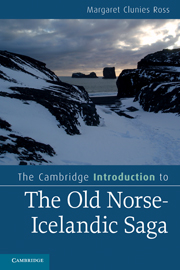Book contents
- Frontmatter
- Contents
- Tables
- A preface on practical issues
- Acknowledgements
- Abbreviations
- Chapter 1 Medieval Iceland
- Chapter 2 What is an Old Norse-Icelandic saga?
- Chapter 3 The genesis of the Icelandic saga
- Chapter 4 Saga chronology
- Chapter 5 Saga subjects and settings
- Chapter 6 Saga mode, style and point of view
- Chapter 7 Saga structures
- Chapter 8 The material record: how we know the sagas
- Chapter 9 Changing understandings of the sagas
- Notes
- Glossary of technical terms
- Guide to further reading
- References to volumes in the Íslenzk fornrit editions of Icelandic sagas
- Index
Chapter 7 - Saga structures
Published online by Cambridge University Press: 05 June 2012
- Frontmatter
- Contents
- Tables
- A preface on practical issues
- Acknowledgements
- Abbreviations
- Chapter 1 Medieval Iceland
- Chapter 2 What is an Old Norse-Icelandic saga?
- Chapter 3 The genesis of the Icelandic saga
- Chapter 4 Saga chronology
- Chapter 5 Saga subjects and settings
- Chapter 6 Saga mode, style and point of view
- Chapter 7 Saga structures
- Chapter 8 The material record: how we know the sagas
- Chapter 9 Changing understandings of the sagas
- Notes
- Glossary of technical terms
- Guide to further reading
- References to volumes in the Íslenzk fornrit editions of Icelandic sagas
- Index
Summary
The two previous chapters have been concerned to identify a number of important characteristics of the medieval saga. Chapter 5 dealt with the subject-matter of Icelandic sagas, a topic that included chronological and geographical settings as well as character types, while Chapter 6 analysed their literary modes, styles and points of view. The present chapter investigates the sagas’ literary forms, that is, the structural components within and through which the substance of the narrated content is deployed and expressed. Unlike some of the other characteristics of the saga already discussed, some aspects of narrative structure are not always obvious at the level of close literary reading, but rather are immanent in the narrative and sometimes across a number of narratives within the same genre, thus constituting an autonomous layer of meaning, described by Greimas as ‘a sort of common structural trunk, at which narrativity is situated and organized prior to its manifestations’.
The twentieth century, from the 1950s onward, has been the great age of analysis of narrative structures, whether of South American myths (Lévi-Strauss), Russian wonder tales (Vladimir Propp) or modern European novels (Barthes, Brémond, Greimas and many others). It is true that some early works, initially of particular interest to anthropologists and psychologists, appeared before that time. One such was Les rites de passage, an influential study by Arnold van Gennep (first published in 1909; English translation 1960) of the three-phase schema that he argued always accompanied the phenomenon of initiation in human societies. Another early pre-structuralist classic, which later came to influence some literary analysts of saga literature, was Marcel Mauss's Essai sur le don (The Gift), first published in French in 1922–3 and in English translation in 1954. Although Vladimir Propp's work on the morphology of the folktale appeared in Russian as early as 1928, its influence did not make itself generally felt until it had been translated into other European languages. The first English translation was published in 1958, not long after the writings of the French anthropologist Claude Lévi-Strauss had begun to be widely disseminated in the English-speaking world. Another important area of interest in structure came from those who wanted to discover how long, orally composed epic poetry was created, performed and transmitted to later generations. The study of the Homeric epic and the so-called Serbo-Croatian oral epic by Milman Parry and Albert Bates Lord made many medievalists aware for the first time of how the essential building blocks of medieval literature, particularly poetry, but also prose, could have been put together to make larger wholes. Although this work was begun before the Second World War, it was not widely disseminated until the publication of Lord's book, The Singer of Tales, in 1960.
- Type
- Chapter
- Information
- The Cambridge Introduction to the Old Norse-Icelandic Saga , pp. 124 - 139Publisher: Cambridge University PressPrint publication year: 2010



